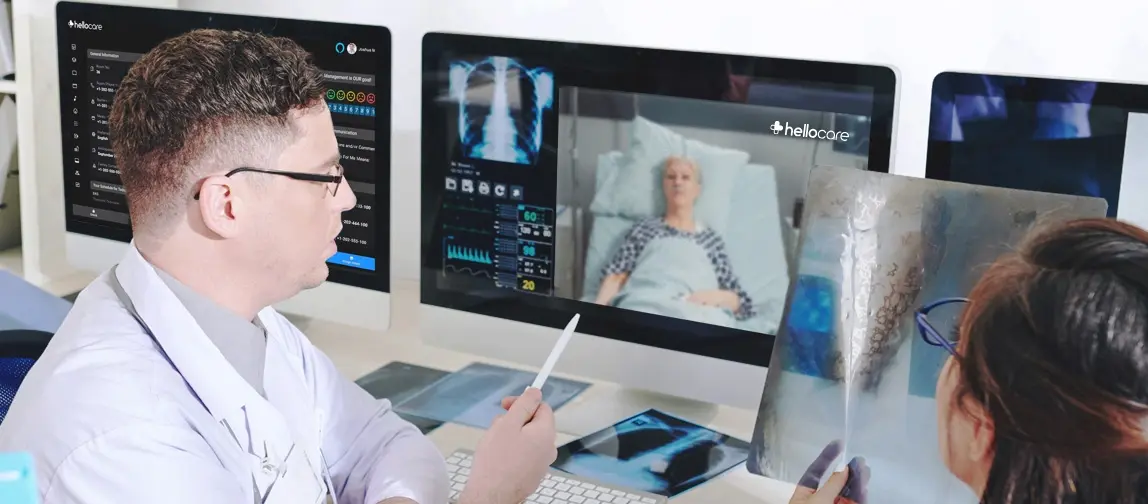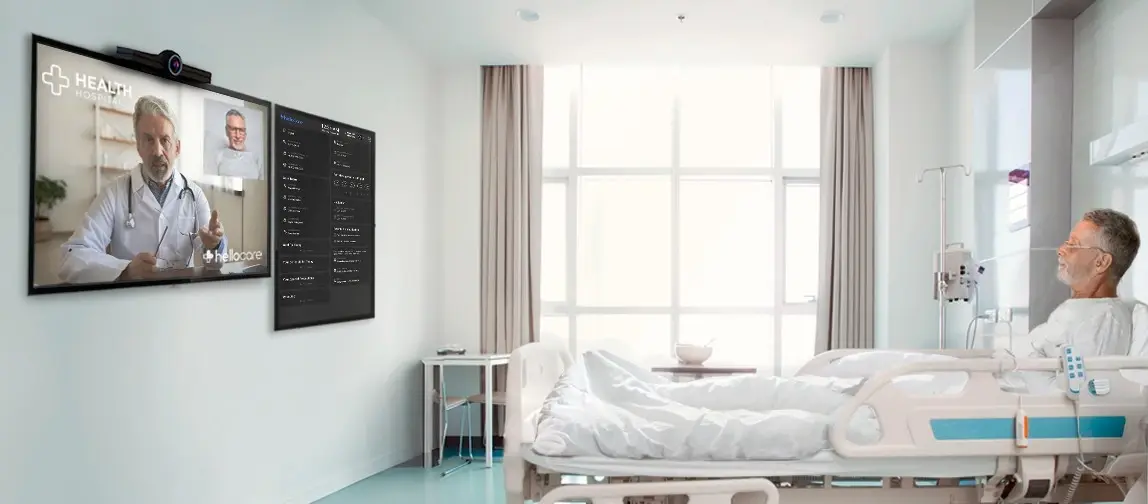Redefining Healthcare
The Role of Virtual Rounding in Process Improvement
May, 2024 1:05:39 PM
.webp)
The digitization of healthcare, a market valued at USD 233.5 billion in 2022, is projected to nearly quadruple to
USD 981.5 billion by 2032 [1]. This massive growth is a testament to the potential of technology to revolutionize
healthcare practices, from patient interactions to administrative processes. One of the game-changing innovations within
this digital surge is virtual rounding. Its emergence and adoption indicate a shift from traditional patient-care methods,
steering the future of healthcare towards a more efficient, patient-centered model.
hellocare stands at the forefront of this digital revolution, championing the benefits and efficiencies of virtual rounding. By integrating technology with patient care, hellocare offers healthcare providers the tools to monitor patients more effectively, ensuring that care is not only timely but also tailored to individual needs. This pioneering approach has indicated sweeping changes in hospital processes and resource distribution.
Virtual rounding leverages advanced technology to enable healthcare providers to monitor patients effectively from afar.
This method not only ensures that care is timely and tailored to each patient's needs but also allows for greater flexibility
in responding to patient conditions as they change. By integrating virtual rounding tools, healthcare facilities can maintain
continuous communication between patients and their care teams, which is crucial for monitoring chronic conditions or recovery post-surgery.
In traditional settings, nurses often spend a substantial portion of their shifts moving around hospital facilities.
Virtual rounding significantly reduces this need, allowing nurses to focus more on providing direct patient care rather than
on logistical tasks. This efficient use of nursing time not only enhances the quality of patient care but also allows healthcare
facilities to manage patient care more effectively. By spending less time in transit, nurses can allocate more time to patient
consultations, care planning, and immediate patient needs, leading to an overall improvement in care delivery and patient outcomes.
The use of virtual rounding tools helps in optimizing the nurse-to-patient ratio, effectively alleviating the pressure on nursing staff.
This optimized distribution of workload leads to better-managed care schedules, allowing nurses to provide more personalized attention
to each patient. The reduction in workload and the ability to focus more on patient care rather than administrative tasks contribute
to higher job satisfaction among nurses, potentially reducing burnout and improving retention rates in the healthcare workforce.
hellocare stands at the forefront of this digital revolution, championing the benefits and efficiencies of virtual rounding. By integrating technology with patient care, hellocare offers healthcare providers the tools to monitor patients more effectively, ensuring that care is not only timely but also tailored to individual needs. This pioneering approach has indicated sweeping changes in hospital processes and resource distribution.
Enhanced Monitoring and Care Delivery
Increased Nurse Efficiency and Quality of Patient Care
Optimizing Workload Distribution
Reduction in Infection Risks
Virtual rounding plays a critical role in minimizing the physical interactions that lead to the spread of infections within
healthcare settings. By reducing the need for physical presence during rounds, virtual rounding can help decrease the incidence
of hospital-acquired infections, a significant concern for both patient safety and hospital management. This aspect of virtual care
is particularly pertinent in the context of infectious disease management, where limiting contact can directly reduce the risk
of outbreak spread among patients and staff.
.webp)
Improvement in Patient Experience and Satisfaction
Future Directions of Virtual Rounding with hellocare
Addressing Healthcare Challenges
Enhancing Patient Satisfaction and Outcomes
Sustainability and Patient-Centered Care
Reshaping Healthcare Delivery
In this digital age, the trajectory of healthcare's transformation through technologies like virtual rounding is clear—promising a future where efficiency, patient well-being, and top-tier care quality are the hallmarks of the healthcare industry.
Key points
- The digitization of healthcare, a market valued at USD 233.5 billion in 2022, is projected to nearly quadruple to USD 981.5 billion by 2032.
- In traditional settings, nurses often spend a substantial portion of their shifts moving around hospital facilities. Virtual rounding significantly reduces this need.
- Virtual rounding plays a critical role in minimizing the physical interactions that lead to the spread of infections within healthcare settings.
- hellocare, is at the forefront of this transformation, leveraging virtual rounding to address immediate operational challenges such as staffing shortages and the need for efficient care delivery
80%
reduction in RN end of shift overtime
reduction in RN end of shift overtime
35%
reduction in nursing turnover based on support from virtual nurse
reduction in nursing turnover based on support from virtual nurse
350%
increase in bedside RN time spent administering medications
increase in bedside RN time spent administering medications
350%
increase in bedside RN time spent administering medications
increase in bedside RN time spent administering medications
Share Article
Care to know more?
Request a demo to be informed about the latest virtual nursing news and telehealth...
Related posts


